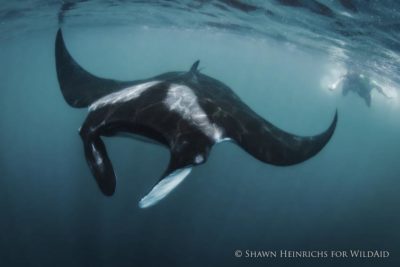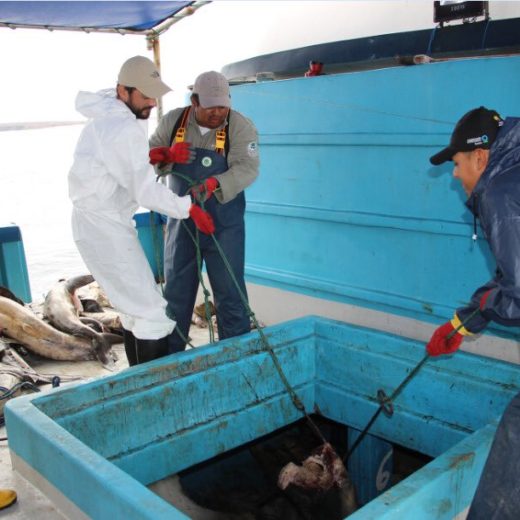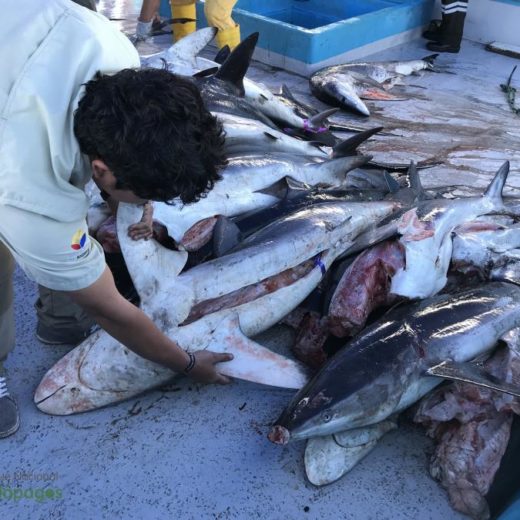
BEIJING — A WildAid report summarizing recent market and consumer surveys reveals an alarming and unsustainable increase in the number of manta and mobula rays killed to supply a single ingredient – their gills – for a pseudo-medicinal health tonic. In addition, toxicology tests of Guangzhou market samples detected Arsenic and Cadmium levels far exceeding permissible limits of heavy metals in herbal medicines and foods as outlined by the Pharmacopoeia of China. These results raise concerns about potential and significant public health risks associated with ingesting these dried gills (product name: “Peng Yu Sai”).
With an estimated 99% of the world’s manta gill consumers located in Guangzhou, China, WildAid has launched a multimedia campaign including billboards, social media, television and radio messages, as well as in-depth TV news stories to inform the public of the ecological and potential human health impacts of consuming Peng Yu Sai.
“Guangzhou has quickly become the hub of the manta ray gill trade, and our surveys suggest a surge in consumption that has more than doubled over the last three years,” said Peter Knights, Executive Director of WildAid. “Together with assistance from the Chinese government and Traditional Chinese Medicine practitioners, we will raise awareness among China’s consumers of the trade of manta ray gills and the issues surrounding their alleged medicinal values. In an independent, public survey we concluded earlier this month, we discovered that a majority of consumers are unaware that mantas are endangered and would gladly stop eating the gills once informed of this status.”
MANTAS IN THE MARKETS:
- The Guangzhou manta and mobula gill plate market is now estimated at 138,000 kg per year worth US$30 million, representing gills from approximately 147,000 mantas and mobulas annually;
- Arsenic, Cadmium, Mercury, and Lead were detected in all manta and mobula gill plates sampled from the Guangzhou markets with Arsenic found at 20x the levels permissible by the Pharmacopoeia of China and Cadmium at triple the permissible levels;
- 99% of 100 Guangzhou Peng Yu Sai consumers surveyed in 2014 were unaware of the presence of heavy metals in the product;
- The surveys’ results suggested a demographic of Peng Yu Sai consumers comprised primarily of working mothers/wives, over 40 years of age with less than half of all respondents knowing the source – manta and mobula rays – of the product.
Though not historically recognized as official Traditional Chinese Medicine (TCM), industry marketing appears to be increasing, promoting Peng Yu Sai (mobulid dried gill plates) for greater acceptance, across a broader demographic as a ‘healthy’ soup, especially in South China. All interviewed vendors asserted their claims which they promote to their customers, that the product aids in preventing, relieving, or curing a range of diseases and complaints including: cancer, chicken pox, chronic cough, fever, and acne; boosts the immune system and supports lactation in new mothers all by purifying the blood to promote general good health. The presence of toxic heavy metals in Peng Yu Sai, at dangerously high levels in many of the samples tested from the markets, directly contradicts claims of the product providing health benefits via detoxification and raises important concerns about its promotion to and use by lactating mothers and children.
There are no scientifically proven health benefits associated with the consumption of dried manta and mobula gill plates.
In 2009-10, WildAid conducted market surveys of Peng Yu Sai in China and throughout Southeast Asia. The markets were surveyed for species, stock, price, demand/supply, and product use/perception. The updated 2013 survey of the same markets in Guangzhou suggests an alarming increase in the Peng Yu Sai market in just three years:
Estimates:
Market Volume (kg): 61,000 (2010) v. 138,000 (2013) – 126% increase
Market Value (US$): $11 million (2010) v. $30 million (2013) – 168% increase
Mantas and Mobulas Consumed (individuals): 49,000 (2010) v. 147,000 (2013) – 198% increase
Manta and mobula populations cannot withstand the pressure of continually increasing market-driven demand for their gill plates. Already known to be among the slowest to reproduce of all sharks and rays, newer data on manta ray reproduction suggest that they may reproduce even more slowly than previously believed, with a maximum lifetime reproduction potential estimated at only 5-15 offspring. The combination of manta and mobula ray slow reproduction with targeted or unregulated/unrecorded fisheries, and current evidence of increasing market demand for their gill plates, suggests that the market-based threat to manta and mobula populations is still increasing and the need for conservation action even more immediate today. While this alarming increase may reflect conservative market estimates in 2010, there are strong indications that the Peng Yu Sai market has increased substantially over the three years and is continuing to expand: increases in average prices for the three main types of Peng Yu Sai of 10% to 40%; consistent reports from vendors of increasing demand combined with a perception of decreasing availability of supply; evidence of increased mainstream media and on-line marketing of Peng Yu Sai to reach a broader demographic combined with promotion of regular monthly use for general health; and on-the-ground observations during both 2010 and 2013 surveys of a dramatic, overall increase in Peng Yu Sai stock in the Guangzhou markets.
ACTION FOR MANTAS AND MOBULAS:
After successful lobbying by WildAid and other conservation organizations to list manta rays on Appendix II as an endangered species at last year’s Convention on International Trade in Endangered Species of Wild Fauna and Flora (CITES), WildAid now seeks to raise awareness and significantly reduce and eventually eliminate demand among the principal consumers of manta ray gills at the heart of the trade, in Guangzhou, China.
In 2014, INTAGE China, a third-party survey company, partnered with WildAid to survey 1,000 respondents online and 100 purchasers of Peng Yu Sai at Guangzhou markets to ascertain consumer awareness and behavior and to inform WildAid’s demand-reduction campaign for culturally appropriate and effective messaging and communications.
Earlier this year WildAid, in collaboration with local and international conservation initiatives, assisted the Government of Indonesia in developing and issuing a regulation providing for full protection of Oceanic and Reef Manta Rays (Manta birostris and Manta alfredi) in Indonesian waters, creating the world’s largest manta sanctuary encompassing a massive 6 million square kilometres.
Stay in touch and get the latest WildAid updates.
SIGN UPAbout WildAid
WildAid is a non-profit organization with a mission to protect wildlife from illegal trade and other imminent threats. While most wildlife conservation groups focus on protecting animals from poaching, WildAid primarily works to reduce global consumption of wildlife products such as elephant ivory, rhino horn and shark fin soup. With an unrivaled portfolio of celebrity ambassadors and a global network of media partners, WildAid leverages more than $308 million in annual pro-bono media support with a simple message: When the Buying Stops, the Killing Can Too.
Journalists on deadline may email communications@wildaid.org


